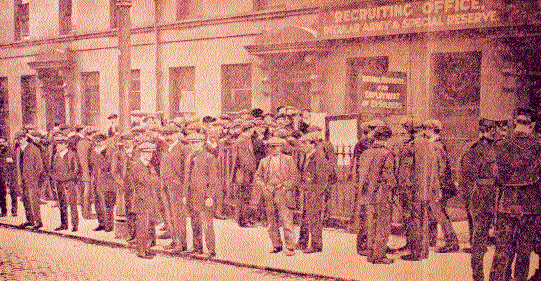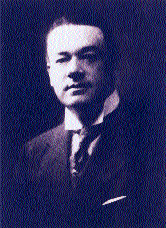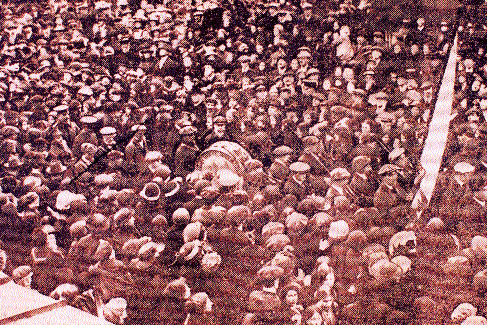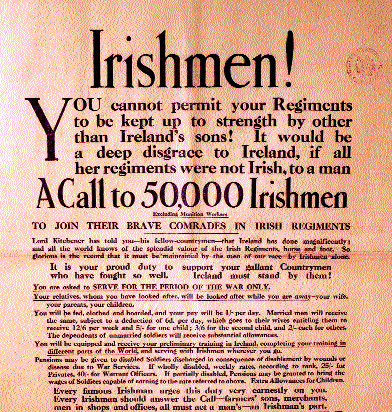For king, country and a shilling a day
Published in 18th–19th - Century History, 20th-century / Contemporary History, Features, Issue 4 (Winter 2003), Volume 11 In the Great War, Belfast contributed more voluntary recruits per head of population than any other part of Ireland. Out of an Irish recruiting total of some 144,000 men, Belfast—which represented less than a tenth of the Irish population—provided 46,000. What factors motivated so many Belfast men to enlist? A unionist interpretation, formed during the war itself, tends to dominate popular accounts. It highlights the ‘loyal traditions’ of the Protestant majority as the prime element driving the city’s recruiting returns and places special emphasis on the role of the Ulster Volunteer Force and on the raising of the 36th (Ulster) Division. It is a view that has ignored, or at best downplayed, the role of Catholics and nationalists. For example, in December 1914 the unionist Belfast News Letter, commenting on Belfast recruiting, argued that, ‘while the nationalists are almost one quarter of the population of the city, they have contributed one tenth of the volunteers’.
In the Great War, Belfast contributed more voluntary recruits per head of population than any other part of Ireland. Out of an Irish recruiting total of some 144,000 men, Belfast—which represented less than a tenth of the Irish population—provided 46,000. What factors motivated so many Belfast men to enlist? A unionist interpretation, formed during the war itself, tends to dominate popular accounts. It highlights the ‘loyal traditions’ of the Protestant majority as the prime element driving the city’s recruiting returns and places special emphasis on the role of the Ulster Volunteer Force and on the raising of the 36th (Ulster) Division. It is a view that has ignored, or at best downplayed, the role of Catholics and nationalists. For example, in December 1914 the unionist Belfast News Letter, commenting on Belfast recruiting, argued that, ‘while the nationalists are almost one quarter of the population of the city, they have contributed one tenth of the volunteers’.
However, analysis of official recruiting statistics shows that, contrary to unionist claims, Belfast Catholics did contribute their full share of the city’s recruits. By the end of 1914, Catholics, who represented some 23.2 per cent of Belfast’s male population, had accounted for 23.1 per cent of the 16,800 recruits raised in the city. Figures collected for 1915 show that Catholic representation actually improved, rising to 27.3 per cent of the city’s 14,500 recruits that year. Thus by the end of 1915 Belfast Catholics had contributed over 7,800 recruits and were over-represented in the city’s recruiting returns.
‘For Ulster and for Ireland’
Prominent among the city’s Catholic and nationalist recruits were members of the local regiment of the Irish National Volunteers (INVs)—the nationalist counterpart to the Ulster Volunteer Force (UVF). Belfast INVs began recruiting in organised bodies after the Nationalist leader, John Redmond, visited the city in October 1914. Nationalist west Belfast was bedecked with Union Jacks and other allied flags to greet him—testimony to the new complexion of relations between Irish nationalists and Britain now that Home Rule was on the statute book, albeit suspended. At Clonard Picture House on the Falls Road, Redmond addressed a rally of Belfast INVs and urged them to join the 16th (Irish) Division for service overseas—to ‘strike a blow in defence of Ireland, where the real fighting is going on’. No one supported Redmond’s recruiting policy more fervently than Joe Devlin, the popular and charismatic MP for West Belfast. Devlin assured his constituents that ‘the war is Ireland’s war quite as much as Great Britain’s or any other part of the Empire’s. However it may have been in the past, England today is fighting the battle of Ireland’s liberty’.

Scenes at Crumlin Road recruiting office in the early days of the war, many weeks before organised enlistments from the Ulster Volunteer Force (UVF) and Irish National Volunteers (INV) began. According to press reports, ‘so great was the crowd at one time, that the doors had to be closed’. (Belfast Evening Telegraph)
In mid-November the first mass detachment of over 600 Belfast INVs left the city to join the 16th (Irish) Division in training at Fermoy, Co. Cork. Thousands of excited spectators lined the city’s main thoroughfare, Royal Avenue, as the new recruits marched in procession to the Great Northern train station, accompanied by nationalist pipe bands. Similar scenes were enacted the following week when a second batch of around 300 INV recruits left the city. By the end of 1914 over 1,200 Belfast INVs had joined the 16th Division. On top of this, a further 1,200 had rejoined the colours as reservists shortly after war was declared, while unknown numbers joined various Irish and non-Irish units outside the 16th Division. These were highly creditable figures from an organisation that, in Belfast, boasted a pre-war strength of just 4,000. Moreover, the Belfast INV response represented just a fraction of the overall contribution made by the city’s Catholics. Of almost 4,000 Belfast Catholics who enlisted in 1915, over three quarters had no INV links.
However, recruiting rates among Belfast Catholics were exceptional. Police statistics show that they were four times as likely to enlist as Catholics from other parts of Ulster. Similar patterns were evident in Protestant Ulster—a telling example being that Belfast Protestants recruited at over three times the rate of their co-religionists in the unionist heartlands of Antrim and Down. One important consequence of this was that men from Belfast were markedly over-represented in the Ulster Division.
Belfast UVF members had been first to enroll into the 36th (Ulster) Division after Sir Edward Carson announced its formation on 3 September 1914. At a meeting in the Ulster Hall, Carson encouraged UVF members to join the new division—to ‘go and help to save your country and to save your Empire. Go and win honour for Ulster and for Ireland’. The following day he inspected a parade of over 700 men of the North Belfast UVF, before leading them down to the Old Town Hall to enlist. This marked the start of a ten-day period of carefully stage-managed and highly organised enrolments involving all four regiments of the Belfast UVF.
By the end of September over 5,600 members of the Belfast UVF had joined the Ulster Division. On the face of it, this seems an impressive figure. However, in reality it represented less than a fifth of the 30,000 members enrolled in the Belfast UVF before the war. Of the other four fifths, unknown numbers were over-age while others had rejoined the army as reservists or enlisted voluntarily into units outside the Ulster Division. What is clear is that the Belfast UVF did not transfer en masse into the Ulster Division as a complete body. Nevertheless, the four battalions of Royal Irish Rifles that comprised the so-called ‘Belfast Brigade’ in the division all succeeded in reaching establishment strength by the end of September 1914. By contrast, battalions of the Royal Inniskilling Fusiliers, recruiting in the rural west of Ulster, were struggling to make up their numbers, with some units barely half-filled. Clearly, urban–rural considerations were of huge importance in determining patterns of recruitment, regardless of political or religious affiliations.
‘A very big attraction’
To fully understand recruiting patterns in Belfast we therefore need to look past the city’s sectarian divisions at underlying social and economic forces. The first important point to make is that the period of most concentrated recruiting in Belfast coincided with a time of severe economic dislocation in the city. The outbreak of war had disrupted foreign trade, interrupting the supply of raw materials upon which Belfast manufacturing depended. This had immediate and profound effects on the city’s three big industries—shipbuilding, engineering and linen. Thousands of Belfast workers were laid off or put on short time, and in the prevailing atmosphere of economic uncertainty many men felt impelled to enlist to save themselves and their families from financial distress. However, by mid-September Belfast shipbuilding and engineering began to show signs of recovery; workers were re-employed, foundries reopened, and for many firms and their employees the worst of the economic crisis was over. Significantly, it also marked the end of the recruiting boom in Belfast—a trend shared with many industrial centres in Britain.

Joe Devlin, Irish Parliamentary Party MP for West Belfast, campaigned tirelessly in his native city for recruits to the 16th (Irish) Division.
It is also notable that recruiting rates varied greatly between different sections of the Belfast working classes. In particular, skilled men were markedly under-represented at the front compared to the unskilled. A roll of honour unveiled in the boiler shop of the Harland and Wolff shipyard in 1917 recorded the names of 260 workers from that department who had joined the forces; of these, just 36 were skilled boilermakers or machinemen, while 42 were apprentices and 182 were unskilled ‘helpers’. The 36 skilled men represented less than five per cent of the skilled workers employed in the boiler shop before the war; in sharp contrast, the 183 unskilled men represented 23 per cent of their pre-war strength.

Street scenes in Belfast as the first batch of INV recruits parade to the Great Northern railway station, accompanied by nationalist bands. (Belfast Evening Telegraph)
There were two main reasons for this disparity: first, the large gap in wage rates between skilled and unskilled workers; second, the preferential treatment given to skilled men by government officials, employers and recruiting agents. In 1914 a tradesman in Belfast earned around 35–45 shillings a week. Unskilled men made less than half these rates—just 15–20 shillings a week—and even then only if in regular employment. Younger men or ‘boys’ suffered from particularly exploitative rates of pay, on top of which it was common practice for firms to lay off young workers as soon as they turned eighteen years of age and qualified for adult wage levels. In 1914 basic army pay amounted to just seven shillings a week—‘a shilling a day’. For married men, half went automatically to wives at home, who, in addition, received a separation allowance of 12s 6d. Separation allowances increased according to the number of children in a family, so that, for example, a wife with three children received 20 shillings a week, including the portion allocated from her husband’s pay.
For a family depending on the low and often irregular wages of an unskilled labourer, such levels of remuneration and their regularity were financially attractive. For young single men, out of work or in dead-end jobs, army pay and conditions were also appealing. As one Ulster Division veteran, who had enlisted under-age, recollected in later years:
there was nothing in life worth having in those days; and a man, a young fellow, was glad to get away and know that he was going to get somewhere around nine shillings a week to live on in the army; and of course he had his food and clothing and his accommodation thrown in and it was a very big attraction.
On the other hand, for a skilled man and his family army pay and conditions represented a considerable drop in income—a decrease he was unlikely to accept unless out of work or on short time.
While many skilled workers were made unemployed by the outbreak of war, they were much less likely than unskilled men to find themselves in such a situation. For example, when in 1914 the economic downturn bit hard at the Harland and Wolff shipyard, the firm’s management decided to selectively reduce their workforce rather than put all employees on short time. Skilled workers were retained in preference to the unskilled, thus reducing the risk of losing men ‘whom it is important for us to keep’.
‘Serving their country equally’
Furthermore, of the skilled men who did enlist in the first weeks of war, large numbers got the opportunity to return to civil employment once the economic situation improved. From early 1915 the government introduced a succession of schemes aimed at releasing skilled men from the forces to work in industries vital to the war effort. Tradesmen from Belfast were among the thousands thus reclaimed for shipbuilding, engineering and munitions work. In mid-1915 Harland and Wolff and various engineering firms in the city became government-controlled establishments with their employees classed as ‘munitions workers’, exempt from military service.
As the idea of exempt status took hold, skilled men in particular took vigorous steps to protect their position within the workforce. Backed by a strong tradition of trade unionism, they consistently—and largely successfully—resisted various pro-posals to dilute the labour force with unskilled or semi-skilled labour. As the war dragged on, jobless artisans in Belfast increasingly looked to war work rather than soldiering to deliver them from financial hardship. In July 1915 over 600 unemployed tradesmen gathered to protest at what they saw as ‘the continued indifference of the government in ignoring our repeated claims in the manufacture of munitions or other essential work’. In a resolution passed at the meeting they made this plea to the government: ‘All we ask is a chance to show our willingness to engage in any work that will be a mutual benefit to our country and ourselves, our wives and our families’.
Such an outlook was encouraged by local business leaders and politicians who constantly reassured Belfast war workers that ‘they were serving their country equally with those who are fighting in the trenches’. At a practical level, the Belfast Employers War Munitions Committee, formed in May 1915, worked hard to secure armaments contracts for firms in the city. Artisans who still found themselves out of work could volunteer to work in munitions factories elsewhere in the United Kingdom under the War Munitions Volunteers scheme introduced by the government in mid-1915.
In comparison, unskilled workers had fewer options available to them and were in a much less secure position than skilled men. Their lack of skills and sheer numbers made them easily replaceable, while their low social status and relative lack of trade union influence denied them a strong collective voice. They were thus ill equipped to withstand the increasingly high-pressure tactics used by recruiting bodies to simultaneously push and entice them into military service. Even in protected establishments unskilled men could not take exemption for granted. In 1918 the government, desperate for additional military manpower, made growing demands on industry to remove exempt status from some classes of war worker. Harland and Wolff responded by withdrawing war service badges from the unskilled and semi-skilled sections of their workforce only, thereby selectively exposing them to the attentions of recruiters.
The attitudes of individual employers had a very important impact on recruiting in the workplace. These varied from paternalistic encouragement to selfish exploitation. Public sector employers, like the Belfast Corporation and the Post Office, were proactive in promoting recruitment in the workplace. On top of this, they offered financial allowances to employees who enlisted and promised to keep their jobs open while on active service. Replacement labour was usually taken on from groups not eligible for military service—under-age boys, over-age men and (though to a much lesser extent) women. In the private sector such schemes were implemented unevenly, if at all. Some employers, like Sirocco Engineering, introduced comprehensive schemes similar to the Corporation’s. However, for other, less scrupulous employers wartime conditions merely offered a ‘patriotic’ pretext for laying off eligible men and replacing them with cheap labour from the ineligible categories.
In spring 1915 a newly formed body, the Belfast Businessmen’s Recruiting Committee, undertook a bold initiative aimed at directly involving more employers in the work of recruiting as well as at standardising recruitment policies across the city’s workplaces. The committee proposed to contact every employer in the city with a view to identifying eligible men still in their workplaces and encouraging them to enlist. These new methods marked a radical departure from traditional rally tactics towards a more systematic and focused approach. However, the response was disappointing. In many cases the committee was, in its own words, met by ‘an absolute refusal to help’; a month after 4,000 circulars were sent out to employers in Belfast only a quarter had bothered to reply. Also, some concerns were expressed that the new measures smacked of ‘economic compulsion’, stretching the principle of voluntary recruitment to its very limits.
‘Slackers and objects of contempt’
Just as recruiting was uneven across the city’s working classes, so there were inequalities between different sections of the Belfast middle classes. Like the unskilled working classes, young men from upper middle-class backgrounds joined up in impressive numbers—the vast majority of them commissioned as officers. Of the small minority who served in the ranks, most were discriminating in their choice of unit, electing to join exclusive formations such as the public school battalions.
Like artisans, men from lower middle-class backgrounds, such as clerks and shop assistants, were under-represented among Belfast recruits. However, owing to the non-essential and ‘unmanly’ nature of their occupations, they were afforded little of the respect given to war workers. Instead they were roundly denounced as ‘shirkers’ or, as one recruiting officer branded them, ‘the greatest slackers and objects of contempt’.

Edward Carson and James Craig inspecting men of the North Belfast UVF at Donmore House before leading them down to the Old Town Hall to enlist in the Ulster Division. (Belfast Evening Telegraph)
Again, financial considerations and employer attitudes were important influences on lower middle-class recruiting rates. Army pay levels were a financial disincentive to all but the lowliest grades of white-collar worker. Private sector employers, such as banks and commercial concerns, were particularly anxious to limit the loss of highly valued, expensively trained staff and to minimise disruption to business. In late 1914 the Belfast Bank sent out appeals for branch officials to ‘stay at their posts . . . in order to prevent the enforced closure of branches’. To further discourage staff from enlisting, the Belfast Bank—along with the Ulster Bank—found it necessary to suspend its policy of granting half-pay to employees on active service.
Belfast Corporation, on the other hand, kept its allowance schemes in place until the war was over and, indeed, offered more favourable subsidies to office staff who joined up than to manual workers. Despite this, Corporation records show that clerical employees were only half as likely as manual workers to enlist. This suggests that other factors, apart from purely financial ones, deterred white-collar workers from joining up. It seems likely that pre-war prejudices regarding the low status of soldiers persisted among the ‘respectable’ classes.
Attempts were made to stimulate recruiting among white-collar workers by appealing to their highly developed sense of class-consciousness. In a campaign launched in spring 1915, the Belfast Businessmen’s Recruiting Committee worked closely with the Ulster Division to form ‘pals companies’ within the division’s reserve battalions, hoping to emulate the success of the ‘pals battalions’ raised in Britain earlier in the war. In the words of the division’s commander, General Powell, by joining their ‘own platoon or company’ the respectable class of recruit would be saved from having to ‘hob-nob with the boys who stood outside a public house’. However, as with other schemes targeted at the lower middle classes, the results of this initiative fell far short of expectations.

This recruiting advert of October 1915 was printed on the front page of all Belfast newspapers-unionist and nationalist. As well as appealing to national pride and targeting men of the middle classes, the advert details rates of pay and allowances. (Belfast Evening Telegraph)
In conclusion, the traditional view that Belfast’s recruiting performance depended primarily on the loyalty of the city’s Protestant community is clearly flawed and misleading. Instead, recruiting patterns in Belfast were driven by a diverse and complex mix of social and economic factors unique to the city. In large part, the wartime army remained the preserve of the most economically vulnerable sections of society—the unemployed, the unskilled and the underpaid. For Belfast recruits—Protestant and Catholic alike—the material respite afforded by ‘a shilling a day’ was a more fundamental and compelling reason to enlist than abstract, intangible notions of ‘king and country’.
Eric Mercer is an optometrist with a practice in Belfast. He has an MA in Irish Studies through Queen’s University and has written a dissertation on Belfast recruiting in the Great War.
Further reading:
T. Denman, Ireland’s unknown soldiers: the 16th (Irish) Division in the Great War (Dublin, 1992).
T.P. Dooley, Irishmen or English soldiers (Liverpool, 1995).
P. Orr, The road to the Somme: men of the Ulster Division tell their story (Belfast, 1987).
P. Simkins, Kitchener’s armies: the raising of the new armies, 1914–16 (Manchester, 1988).
















